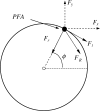Biomechanics and strength of manual wheelchair users
- PMID: 16869087
- PMCID: PMC1808266
- DOI: 10.1080/10790268.2005.11753840
Biomechanics and strength of manual wheelchair users
Abstract
Background/objective: Previous investigations have identified muscular imbalance in the shoulder as a source of pain and injury in manual wheelchair users. Our aim was to determine whether a correlation exists between strength and pushrim biomechanical variables including: tangential (motive) force (Ft), radial force (Fr), axial force (Fz), total (resultant) force (FR), fraction of effective force (FEF), and cadence.
Methods: Peak isokinetic shoulder strength (flexion [FLX], extension [EXT], abduction [ABD], adduction [ADD], internal rotation [IR], and external rotation [ER]) was tested in 22 manual wheelchair users with a BioDex system for 5 repetitions at 60 degrees/s. Subjects then propelled their own manual wheelchair at 2 speeds, 0.9 m/s (2 mph) and 1.8 m/s (4 mph), for 20 seconds, during which kinematic (OPTOTRAK) and kinetic (SMARTWHEEL) data were collected. Peak isokinetic forces in the cardinal planes were correlated with pushrim biomechanical variables.
Results: All peak torque strength variables correlated significantly (P < or = 0.05) with Ft, Fr, and FR, but were not significantly correlated with Fz, FEF, or cadence. Finally, there were no relationships found between muscle strength ratios (for example, FLX/EXT) and Ft, Fr, FR, Fz, or FEF.
Conclusion: There was a correlation between strength and force imparted to the pushrim among wheelchair users; however, there was no correlation found in wheelchair propulsion or muscle imbalance. Clinicians should be aware of this, and approach strength training and training in wheelchair propulsion techniques separately.
Figures
References
-
- Sie IH, Walters RL, Adkins RH, Gellman H. Upper extremity pain in the post-rehabilitation spinal cord injured patient. Arch Phys Med Rehabil. 1992;73:44–48. - PubMed
-
- Curtis KA, Drysdale GA, Lanza D, Kolber M, Vitolo RS, West R. Shoulder pain in wheelchair users with tetraplegia and paraplegia. Arch Phys Med Rehabil. 1999;80:453–457. - PubMed
-
- Robinson MD, Hussey RW, Ha CY. Surgical decompression of impingement in the weight-bearing shoulder. Arch Phys Med Rehabil. 1993;74:324–327. - PubMed
-
- Curtis KA, Dillon DA. Survey of wheelchair athletic injuries: common patterns and prevention. Paraplegia. 1985;23:170–175. - PubMed
-
- Bayley JC. The weight-bearing shoulder. The impingement syndrome in paraplegics. J Bone Joint Surg Am. 1987;69(5):676–678. - PubMed
Publication types
MeSH terms
Grants and funding
LinkOut - more resources
Full Text Sources
Medical

